Improving the Luminescence and Stability of Carbon-Centered Radicals by Kinetic Isotope Effect
Abstract
1. Introduction
2. Results and Discussion
2.1. Synthesis and Structure Characterization
2.2. Photophysical Properties
2.3. Electrochemical Properties
2.4. Theoretical Calculations
2.5. Thermal and Photostability
3. Materials and Methods
3.1. Synthesis of BTM-1DCz and BTM-2DCz
3.2. Synthesis of TTM-1DCz and TTM-2DCz
4. Conclusions
Supplementary Materials
Author Contributions
Funding
Institutional Review Board Statement
Informed Consent Statement
Data Availability Statement
Acknowledgments
Conflicts of Interest
References
- Ai, X.; Evans, E.W.; Dong, S.; Gillett, A.J.; Guo, H.; Chen, Y.; Hele, T.J.; Friend, R.H.; Li, F. Efficient radical-based light-emitting diodes with doublet emission. Nature 2018, 563, 536–540. [Google Scholar] [CrossRef] [PubMed]
- Joo, Y.; Agarkar, V.; Sung, S.H.; Savoie, B.M.; Boudouris, B.W. A nonconjugated radical polymer glass with high electrical conductivity. Science 2018, 359, 1391–1395. [Google Scholar] [CrossRef] [PubMed]
- Cui, Z.; Abdurahman, A.; Ai, X.; Li, F. Stable luminescent radicals and radical-based LEDs with doublet emission. CCS Chem. 2020, 2, 1129–1145. [Google Scholar] [CrossRef]
- Obolda, A.; Zhang, M.; Li, F. Evolution of emission manners of organic light-emitting diodes: From emission of singlet exciton to emission of doublet exciton. Chin. Chem. Lett. 2016, 27, 1345–1349. [Google Scholar] [CrossRef]
- Ma, T.; Li, C.-H.; Thakur, R.M.; Tabor, D.P.; Lutkenhaus, J.L. The role of the electrolyte in non-conjugated radical polymers for metal-free aqueous energy storage electrodes. Nat. Mater. 2023, 22, 495–502. [Google Scholar] [CrossRef] [PubMed]
- Mao, L.; Zhou, M.; Shi, X.; Yang, H.-B. Triphenylamine (TPA) radical cations and related macrocycles. Chin. Chem. Lett. 2021, 32, 3331–3341. [Google Scholar] [CrossRef]
- Li, X.; Tan, W.; Bai, X.; Li, F. Stable Near-infrared-emitting Radical Nanoparticles for Fluorescence Imaging. Chem. Res. Chin. U 2023, 39, 192–196. [Google Scholar] [CrossRef]
- Luo, J.; Rong, X.-F.; Ye, Y.-Y.; Li, W.-Z.; Wang, X.-Q.; Wang, W. Research progress on triarylmethyl radical-based high-efficiency OLED. Molecules 2022, 27, 1632. [Google Scholar] [CrossRef]
- Kubo, T. Synthesis, physical properties, and reactivity of stable, π-conjugated, carbon-centered radicals. Molecules 2019, 24, 665. [Google Scholar] [CrossRef]
- Wang, Z.; Zou, X.; Xie, Y.; Zhang, H.; Hu, L.; Chan, C.C.; Zhang, R.; Guo, J.; Kwok, R.T.; Lam, J.W. A nonconjugated radical polymer with stable red luminescence in the solid state. Mater. Horiz. 2022, 9, 2564–2571. [Google Scholar] [CrossRef]
- Peng, Q.; Obolda, A.; Zhang, M.; Li, F. Organic light-emitting diodes using a neutral π radical as emitter: The emission from a doublet. Angew. Chem. Int. Ed. 2015, 127, 7197–7201. [Google Scholar] [CrossRef]
- Obolda, A.; Ai, X.; Zhang, M.; Li, F. Up to 100% formation ratio of doublet exciton in deep-red organic light-emitting diodes based on neutral π-radical. ACS Appl. Mater. Interfaces 2016, 8, 35472–35478. [Google Scholar] [CrossRef] [PubMed]
- Guo, H.; Peng, Q.; Chen, X.-K.; Gu, Q.; Dong, S.; Evans, E.W.; Gillett, A.J.; Ai, X.; Zhang, M.; Credgington, D. High stability and luminescence efficiency in donor–acceptor neutral radicals not following the Aufbau principle. Nat. Mater. 2019, 18, 977–984. [Google Scholar] [CrossRef] [PubMed]
- Abdurahman, A.; Hele, T.J.; Gu, Q.; Zhang, J.; Peng, Q.; Zhang, M.; Friend, R.H.; Li, F.; Evans, E.W. Understanding the luminescent nature of organic radicals for efficient doublet emitters and pure-red light-emitting diodes. Nat. Mater. 2020, 19, 1224–1229. [Google Scholar] [CrossRef] [PubMed]
- Mattiello, S.; Hattori, Y.; Kitajima, R.; Matsuoka, R.; Kusamoto, T.; Uchida, K.; Beverina, L. Enhancement of fluorescence and photostability of luminescent radicals by quadruple addition of phenyl groups. J. Mater. Chem. C 2022, 10, 15028–15034. [Google Scholar] [CrossRef]
- Matsuda, K.; Xiaotian, R.; Nakamura, K.; Furukori, M.; Hosokai, T.; Anraku, K.; Nakao, K.; Albrecht, K. Photostability of luminescent tris (2, 4, 6-trichlorophenyl) methyl radical enhanced by terminal modification of carbazole donor. Chem. Commun. 2022, 58, 13443–13446. [Google Scholar] [CrossRef]
- Hattori, Y.; Kitajima, R.; Ota, W.; Matsuoka, R.; Kusamoto, T.; Sato, T.; Uchida, K. The simplest structure of a stable radical showing high fluorescence efficiency in solution: Benzene donors with triarylmethyl radicals. Chem. Sci. 2022, 13, 13418–13425. [Google Scholar] [CrossRef]
- Hattori, Y.; Tsubaki, S.; Matsuoka, R.; Kusamoto, T.; Nishihara, H.; Uchida, K. Expansion of Photostable Luminescent Radicals by Meta-Substitution. Chem. Asian J. 2021, 16, 2538–2544. [Google Scholar] [CrossRef]
- Wu, C.; Ai, X.; Chen, Y.; Cui, Z.; Li, F. Effects of Introducing Halogen Atoms to Biphenylmethyl Radical on Photostability, Photophysical and Electroluminescent Properties. Chem. J. Chin. U 2020, 41, 972–980. [Google Scholar] [CrossRef]
- Ding, J.; Dong, S.; Zhang, M.; Li, F. Efficient pure near-infrared organic light-emitting diodes based on tris (2,4,6-trichlorophenyl) methyl radical derivatives. J. Mater. Chem. C 2022, 10, 14116–14121. [Google Scholar] [CrossRef]
- Dong, S.; Xu, W.; Guo, H.; Yan, W.; Zhang, M.; Li, F. Effects of substituents on luminescent efficiency of stable triaryl methyl radicals. Phys. Chem. Chem. Phys. 2018, 20, 18657–18662. [Google Scholar] [CrossRef] [PubMed]
- Gao, Y.; Xu, W.; Ma, H.; Obolda, A.; Yan, W.; Dong, S.; Zhang, M.; Li, F. Novel luminescent benzimidazole-substituent tris (2,4,6-trichlorophenyl) methyl radicals: Photophysics, stability, and highly efficient red-orange electroluminescence. Chem. Mater. 2017, 29, 6733–6739. [Google Scholar] [CrossRef]
- Tong, C.C.; Hwang, K.C. Enhancement of OLED efficiencies and high-voltage stabilities of light-emitting materials by deuteration. J. Phys. Chem. C 2007, 111, 3490–3494. [Google Scholar] [CrossRef]
- Yao, J.; Dong, S.-C.; Tam, B.S.T.; Tang, C.W. Lifetime Enhancement and Degradation Study of Blue OLEDs Using Deuterated Materials. ACS Appl. Mater. Interfaces 2023, 15, 7255–7262. [Google Scholar] [CrossRef] [PubMed]
- Peng, X.; Yeh, C.H.; Wang, S.F.; Yan, J.; Gan, S.; Su, S.J.; Zhou, X.; Zhang, Y.X.; Chi, Y. Near-Infrared OLEDs Based on Functional Pyrazinyl Azolate Os (II) Phosphors and Deuteration. Adv. Opt. Mater. 2022, 10, 2201291. [Google Scholar] [CrossRef]
- Li, W.; Wu, A.; Fu, T.; Gao, X.; Wang, Y.; Xu, D.; Zhang, C.; Sun, Z.; Lu, Y.; Young, D.J. Improved efficiency and stability of red phosphorescent organic light-emitting diodes via selective deuteration. J. Phys. Chem. Lett. 2022, 13, 1494–1499. [Google Scholar] [CrossRef]
- Cheng, J.-F.; Kong, F.-C.; Zhang, K.; Cai, J.-H.; Zhao, Y.; Wang, C.-K.; Fan, J.; Liao, L.-S. Positive isotope effect in thermally activated delayed fluorescence emitters based on deuterium-substituted donor units. Chem. Eng. J. 2022, 430, 132822. [Google Scholar] [CrossRef]
- Murphy, R.B.; Staton, J.; Rawal, A.; Darwish, T.A. The Effect of Deuteration on the Keto–enol Equilibrium and Photostability of the Sunscreen agent Avobenzone. Photochem. Photobiol. Sci. 2020, 19, 1410–1422. [Google Scholar] [CrossRef]
- Cai, Z.; Yan, W.; Guo, R.; Liu, H.; Huo, P.; Yu, G.; Bian, Z.; Liu, Z. Warm-White-Light Perdeuterated Dy (III) Complex with a Photoluminescence Quantum Yield of up to 72% in Deuterated Chloroform. Inorg. Chem. 2023, 62, 6560–6564. [Google Scholar] [CrossRef]
- Velasco, D.; Castellanos, S.; López, M.; López-Calahorra, F.; Brillas, E.; Juliá, L. Red Organic Light-Emitting Radical Adducts of Carbazole and Tris(2,4,6-trichlorotriphenyl)methyl Radical That Exhibit High Thermal Stability and Electrochemical Amphotericity. J. Org. Chem. 2007, 72, 7523–7532. [Google Scholar] [CrossRef]
- Ai, X.; Chen, Y.; Feng, Y.; Li, F. A Stable Room-Temperature Luminescent Biphenylmethyl Radical. Angew. Chem. Int. Ed. 2018, 57, 2869–2873. [Google Scholar] [CrossRef] [PubMed]
- Frisch, M.J.; Trucks, G.W.; Schlegel, H.B.; Scuseria, G.E.; Robb, M.A.; Cheeseman, J.R.; Scalmani, G.; Barone, V.; Petersson, G.A.; Nakatsuji, H.; et al. (Eds.) Gaussian 16; Revision C.02; Gaussian, Inc.: Wallingford, CT, USA, 2019. [Google Scholar]
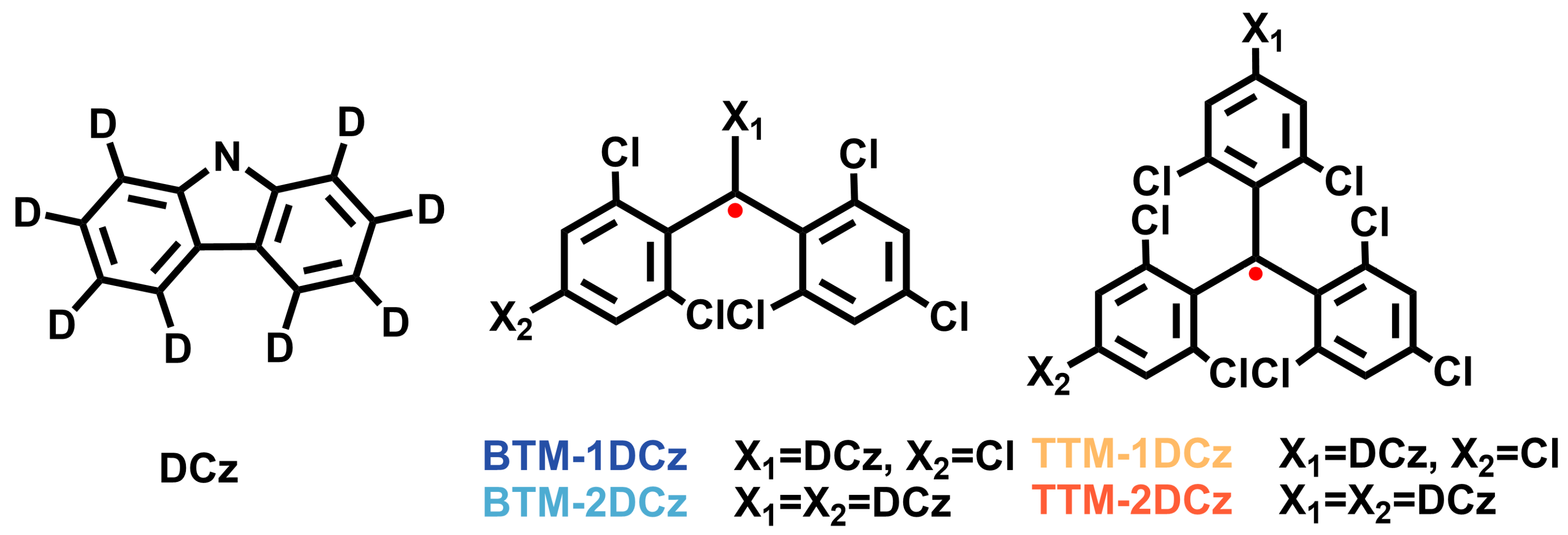
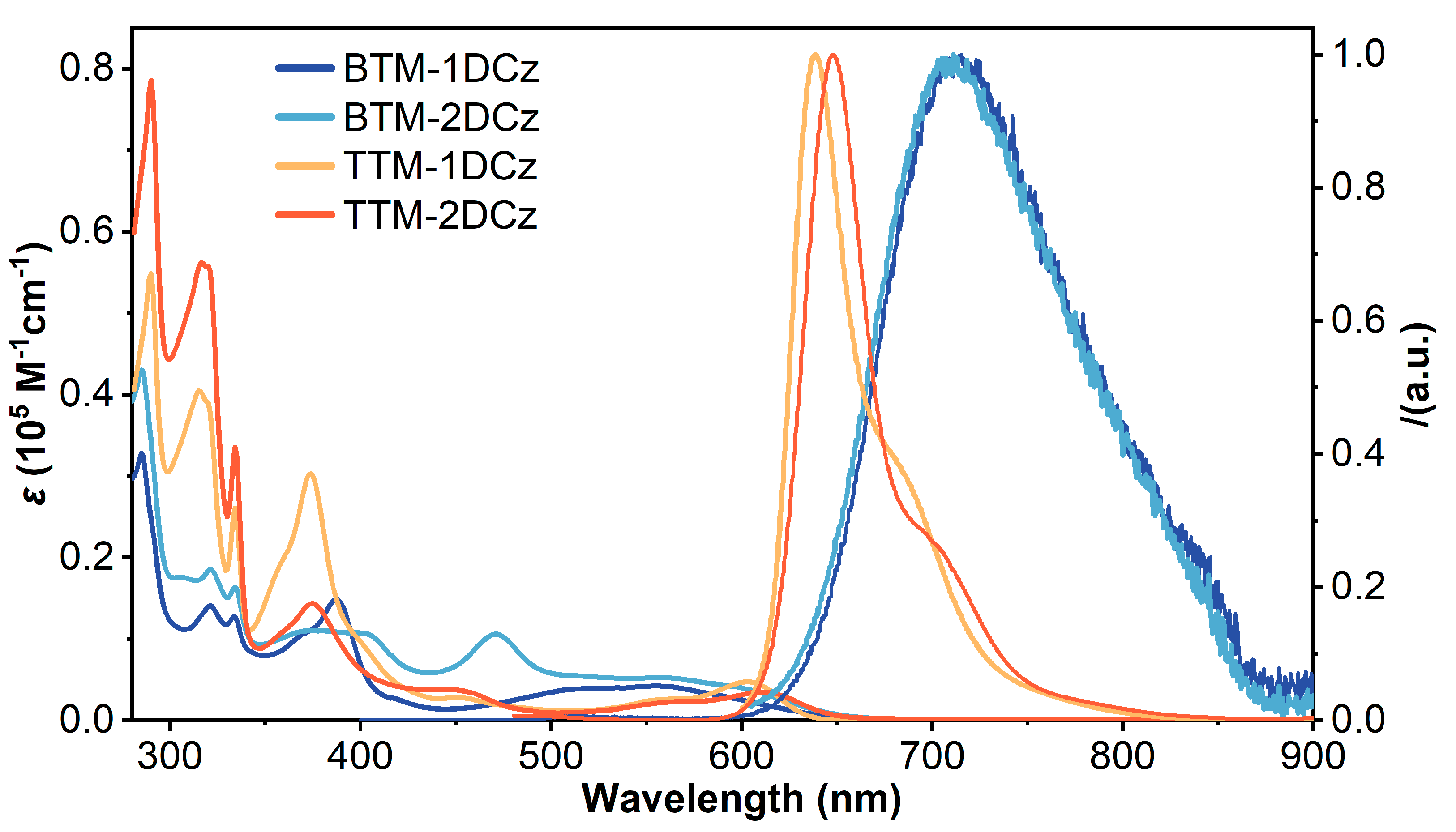
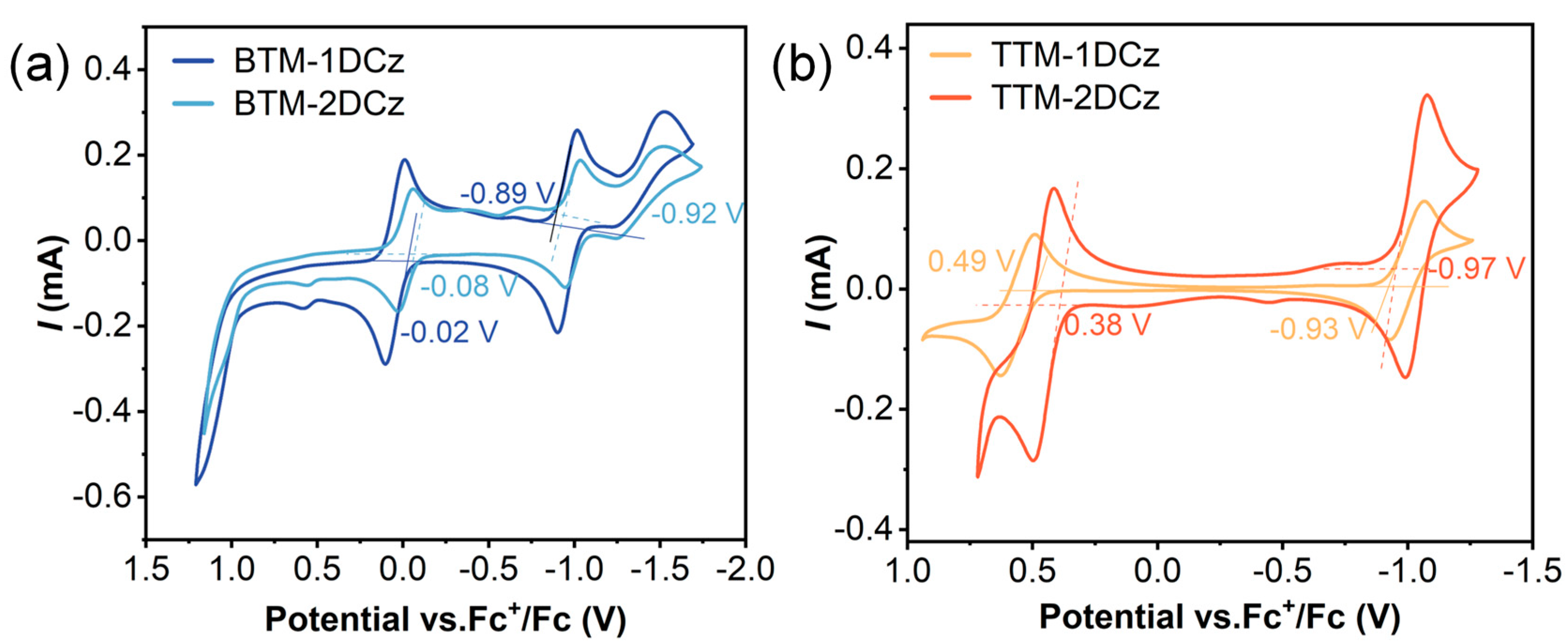
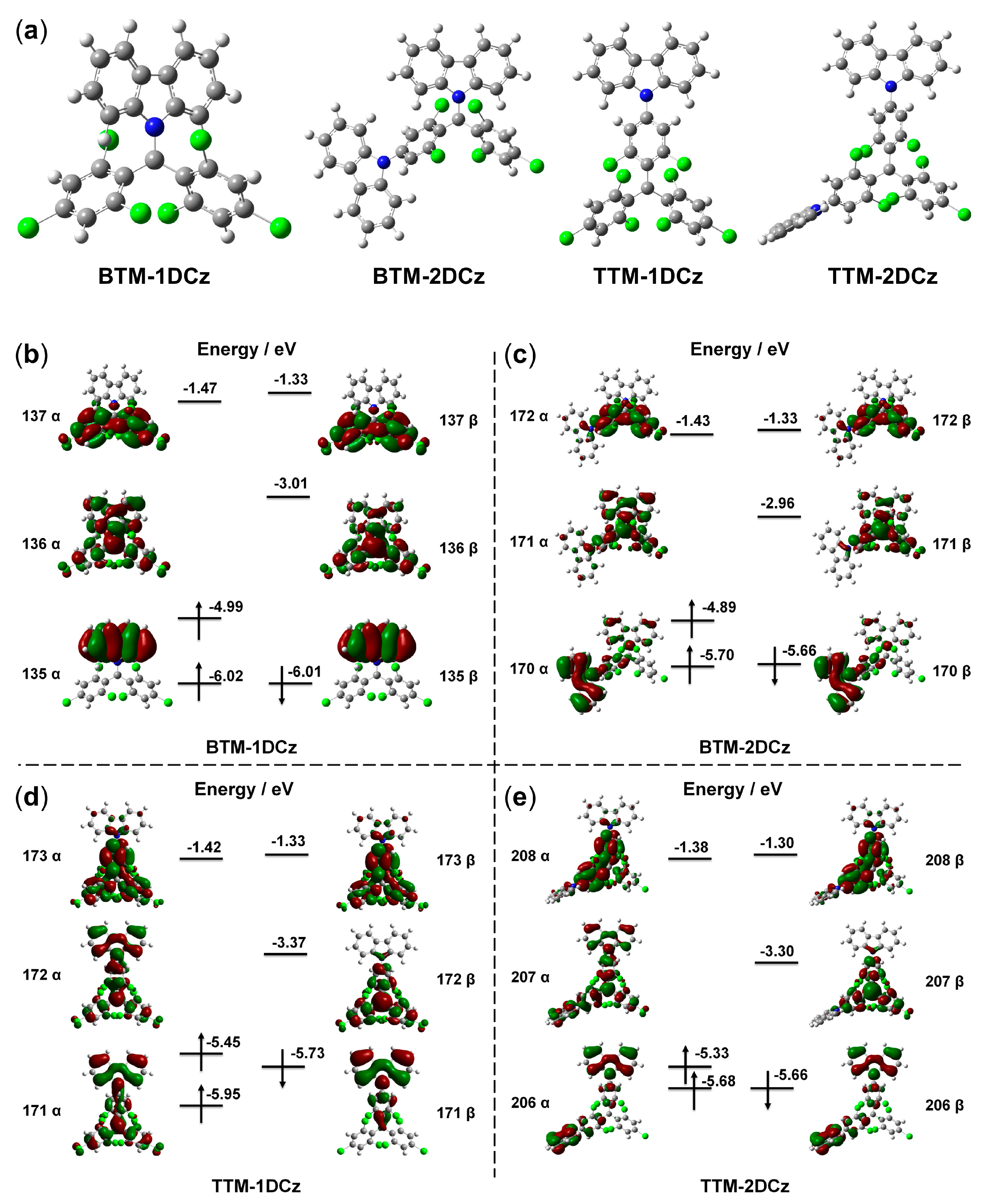
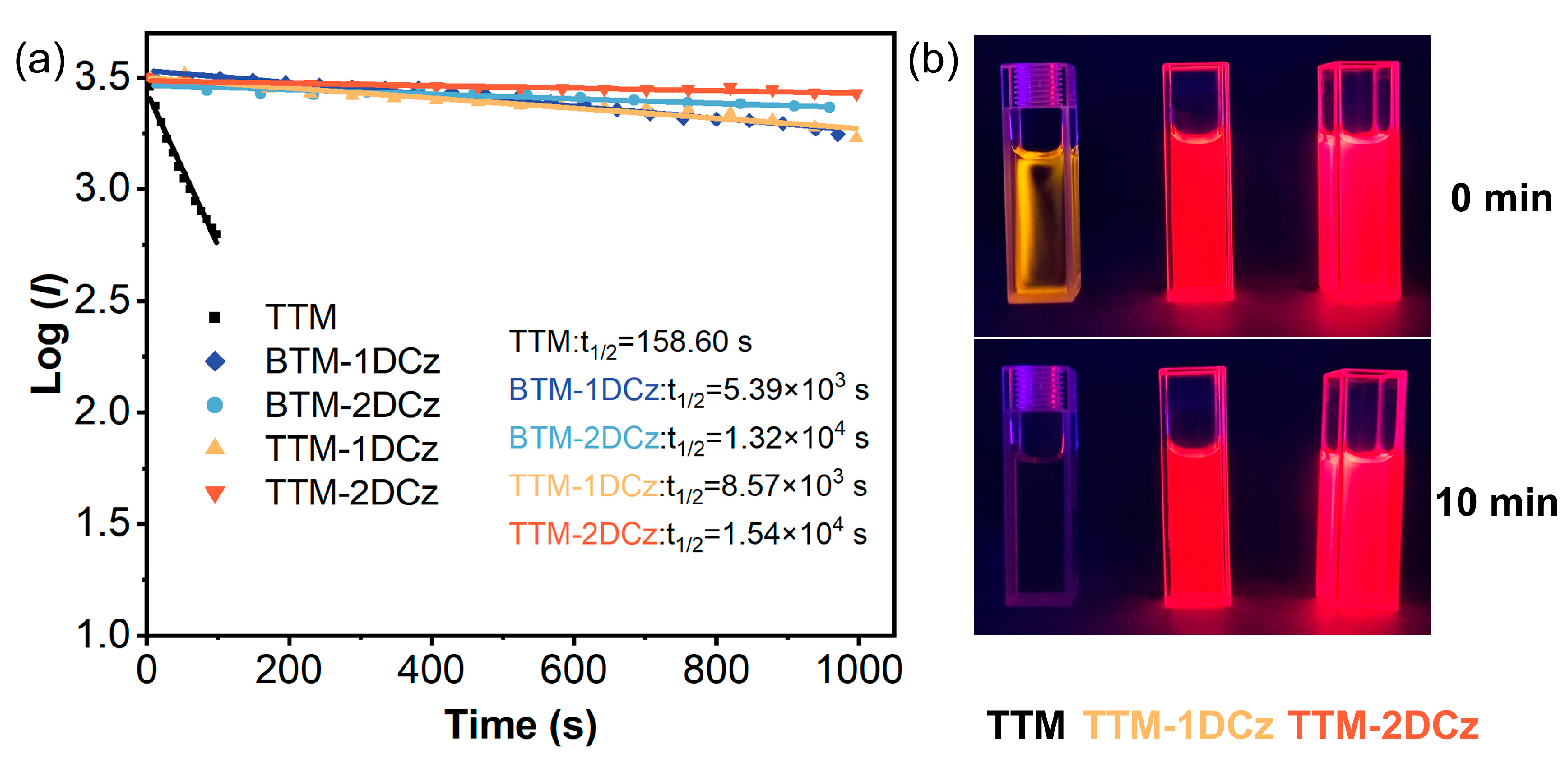
| λEm (nm) | PLQE (%) | τ (ns) | kr (106 s−1) | knr (106 s−1) | |
|---|---|---|---|---|---|
| BTM-1DCz | 711 | 3.0 | 4.5 | 6.7 | 215.5 |
| BTM-1Cz a | 712 | 2.0 b | 4.0 b | 5.0 b | 245.0 b |
| BTM-2DCz | 706 | 3.6 | 4.5 | 8.0 | 214.2 |
| BTM-2Cz | 707 | 3.3 | 4.0 | 8.2 | 241.8 |
| TTM-1DCz | 638 | 78.4 | 41.4 | 19.0 | 5.0 |
| TTM-1Cz | 640 | 53.0 c | 25.3 c | 21.0 | 19.0 |
| TTM-2DCz | 647 | 56.7 | 33.3 | 17.0 | 13.0 |
| TTM-2Cz | 650 | 54.0 c | 28.0 c | 19.0 | 17.0 |
Disclaimer/Publisher’s Note: The statements, opinions and data contained in all publications are solely those of the individual author(s) and contributor(s) and not of MDPI and/or the editor(s). MDPI and/or the editor(s) disclaim responsibility for any injury to people or property resulting from any ideas, methods, instructions or products referred to in the content. |
© 2023 by the authors. Licensee MDPI, Basel, Switzerland. This article is an open access article distributed under the terms and conditions of the Creative Commons Attribution (CC BY) license (https://creativecommons.org/licenses/by/4.0/).
Share and Cite
Ma, Z.; Zhang, L.; Cui, Z.; Ai, X. Improving the Luminescence and Stability of Carbon-Centered Radicals by Kinetic Isotope Effect. Molecules 2023, 28, 4805. https://doi.org/10.3390/molecules28124805
Ma Z, Zhang L, Cui Z, Ai X. Improving the Luminescence and Stability of Carbon-Centered Radicals by Kinetic Isotope Effect. Molecules. 2023; 28(12):4805. https://doi.org/10.3390/molecules28124805
Chicago/Turabian StyleMa, Zhichao, Lintao Zhang, Zhiyuan Cui, and Xin Ai. 2023. "Improving the Luminescence and Stability of Carbon-Centered Radicals by Kinetic Isotope Effect" Molecules 28, no. 12: 4805. https://doi.org/10.3390/molecules28124805
APA StyleMa, Z., Zhang, L., Cui, Z., & Ai, X. (2023). Improving the Luminescence and Stability of Carbon-Centered Radicals by Kinetic Isotope Effect. Molecules, 28(12), 4805. https://doi.org/10.3390/molecules28124805





